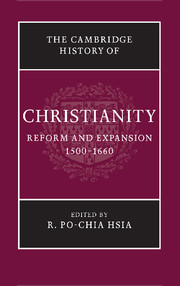Book contents
- Frontmatter
- Part I Luther and the Holy Roman Empire
- Part II The Second Reformation
- Part III Catholic Renewal
- Part IV Resolving Confessional Conflicts
- Part V Religion, Society, and Culture
- 19 The Reformation and the visual arts
- 20 Ritual in early modern Christianity
- 21 Music and religious change
- 22 Demonology, 1500–1660
- 23 Science and religion
- 24 The new clergies
- 25 Women and religious change
- Part VI Christianity and Other Faiths
- Bibliography
- Index
- References
23 - Science and religion
from Part V - Religion, Society, and Culture
Published online by Cambridge University Press: 28 March 2008
- Frontmatter
- Part I Luther and the Holy Roman Empire
- Part II The Second Reformation
- Part III Catholic Renewal
- Part IV Resolving Confessional Conflicts
- Part V Religion, Society, and Culture
- 19 The Reformation and the visual arts
- 20 Ritual in early modern Christianity
- 21 Music and religious change
- 22 Demonology, 1500–1660
- 23 Science and religion
- 24 The new clergies
- 25 Women and religious change
- Part VI Christianity and Other Faiths
- Bibliography
- Index
- References
Summary
The period of religious transformations covered in this volume corresponds closely in time to a series of major scientific developments traditionally known as the ‘Scientific Revolution’, which is commonly considered to extend from the publication of Copernicus’s heliocentric thesis (in De Revolutionibus, 1543) to that of Newton’s laws of physics (in the Principia, 1687). In the course of these 150 years, Aristotelian natural philosophy, which had been dominant since its introduction to the Latin West c. 1200, came under attack in many quarters and gradually lost its hold on the curriculum. Various alternative authorities and new interpretations of nature were advanced, but by 1650 the new philosophy which had become dominant was a mechanical philosophy premised on the notion that all phenomena could be explained as particles of matter in motion, according to mathematical laws open to empirical observation and experimentation. The historiography on the Scientific Revolution is vast. Alongside detailed studies of the central figures and texts of the Scientific Revolution, we have a rich array of studies which highlight the role of the social, cultural, and intellectual contexts of these developments. Among these, religion has long been and continues to be acknowledged as a particularly important factor.
The historiography on science and religion across the centuries predates the professionalization of the history of science and has from the beginning singled out the early modern period for developments which were taken as paradigmatic both of conflict (the Galileo Affair) and of cooperation (‘Protestantism and science’). Although recent work on the interactions between science and religion has moved away from such starkly articulated theses, the early modern period remains a particularly rich area of study.
- Type
- Chapter
- Information
- The Cambridge History of Christianity , pp. 425 - 443Publisher: Cambridge University PressPrint publication year: 2007



